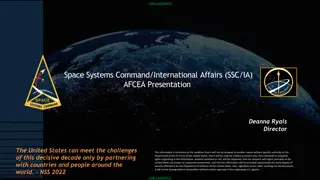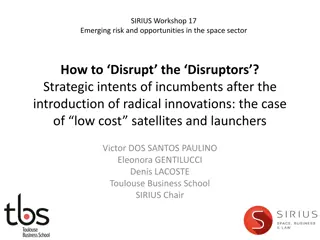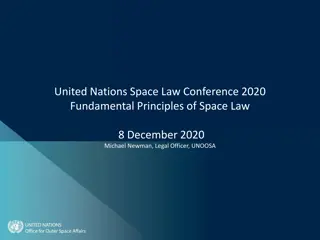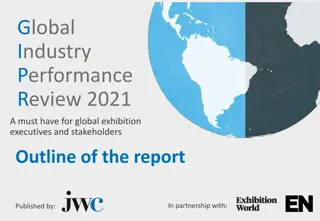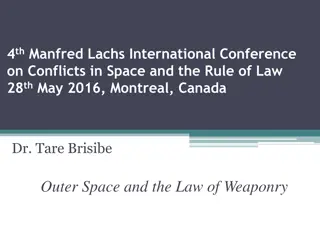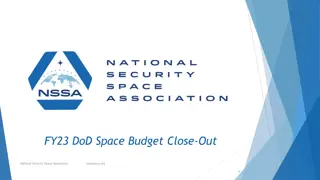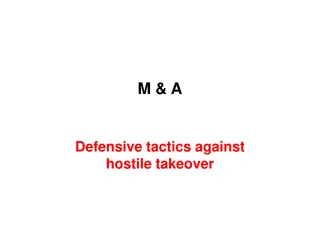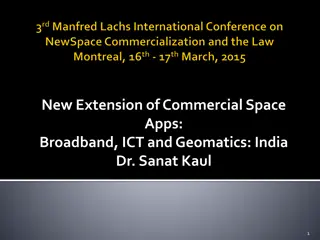Creeping Takeovers in Global Space Industry: Risks and Challenges
Space Industry, Takeovers, Global Trends, Space Economy
Download Presentation

Please find below an Image/Link to download the presentation.
The content on the website is provided AS IS for your information and personal use only. It may not be sold, licensed, or shared on other websites without obtaining consent from the author.If you encounter any issues during the download, it is possible that the publisher has removed the file from their server.
You are allowed to download the files provided on this website for personal or commercial use, subject to the condition that they are used lawfully. All files are the property of their respective owners.
The content on the website is provided AS IS for your information and personal use only. It may not be sold, licensed, or shared on other websites without obtaining consent from the author.
E N D
Presentation Transcript
SPACE INDUSTRIAL WAR : TOWARDS A RISK OF CREEPING TAKEOVERS IN THE GLOBAL SPACE INDUSTRY? Lucien Rapp (Professor), Nad ge Carme (PhD Student), Remy Durand-Carrier (Phd Student) SPACE INSTITUTE FOR RESEARCH ON INNOVATIVE USES OF SATELLITES University of Toulouse, F-31000 Toulouse, France www.chaire-sirius.eu
Scope of the study Facts Findings Increasing number of acquisitions/sales of space industries of 2nd and 3rd tiers (ex. sale of Airbus Group Electronic Defense division to the US investment fund KKR, following a beauty contest where Carlyle was shortlisted) Strategies of 'buy and build ' + interest in firms of tiers 2 and 3 justified by their referencing and qualification Challenging control procedures put in place by States to protect their national interests Risk of creeping takeovers likely to cause a series of exocentric shocks (wars?) Black scenario : (i). (using) space (industry) control, (ii). (in view of) space (sector) dominance, (iii). (towards) (outer)space militarization From private equity funds specializing in space industry(coming from advanced or emerging economies) In a context of consolidations : (i). 2015 as a record year in terms of M&A worldwide ; and (ii). a growing attractiveness of space sector
Macro-economics Global macro-economic context : In 2015, 5 operations of over $ 100 billion (including 3 in the final months of 2015) Factors: (i). currency war + collapse of interest rates; (ii). abundance of cash / role of funds (investment, pension, sovereign, hedge funds); (iii). industrial dynamism (patents); (iv).deteriorating situation of emerging countries ...
Attractiveness of Space Sector Increasing geo-political concerns Current trend of technological innovations in the space industry: increasing use of composites (resin, carbon / glass fiber reinforced plastic) ; improvements in turbine efficiency and propeller technology ; alternate energies / fuels) Opening-up of the space industrial sector : space commercialization; convergence of networks (ultimate convergence ; increasing the number of players; new US industrial dynamism) Expensive cost of big groups subsidiaries in the field of security/defense
Increasing Number of JV YEAR COUNTRY GROUPS JOINT-VENTURES JV FOCUS EU/France Airbus group/Safran Airbus Safran Launchers RGnext (Range generation next) Launchers for commercial and military satellites Research and services on launch optimization systems : Launch and Test Range System (LTRS) Tracking and communication satellite system Research and services on launch optimization systems : Launch and Test Range System (LTRS) Military and civilian satellite services Developer/manufacturerof civil and military services Launchers for commercial and military satellites 2014 USA Raytheon Company/General Dynamics information technology RSC ENERGIA/ Airbus defence and space Lockheed Martin, URS Corporation and InDyne 2013 Russie/EU Energia - Satellite Technologies CoRE (Consolidated Range Enterprise) 2013 USA 2011 France/Italie Thales/Finmecaccanica Telespazio 2007 France/Italie Thales/Finmecaccanica Thales Alenia Space United Launch Allaince 2007 USA Lockheed Martin Space Systems/Boeing Defense, space, security 2006
JVA/JVC 1 3 A B A 2 B A B C 3 A A B B 4 A B C D E F C G
Gradual Emancipation 1960 : Government programs (1960 : 26 (USA) / 29 (CCCP), Moon Missions) 1970 : Licensing and co-production 1980 : Strategic Alliances 1990/2000 : Mergers, acquisitions, absorptions 2010 : Joint Ventures
90/00 Fall of the Berlin Wall and decline in military orders Primacy of civilian programs (communications satellites, launchers) and distortion of the market in favor of civil space Inflection of public supply policies (competitive bidding, savings, PPPs/GOCOs )
00/10 Space Industry Structure Challenged by Highly vertically integrated industries Structuring role of dominant companies (highly concentrated market) Limited productive internationalization (few plants, national, strongly skilled employees) (i). increasing technological complexity, (ii). rise of specialized equipment manufacturers and suppliers (i). outsourcing need : subcontracting of study and ability, (ii). relative decline of the rate of integration (i). transformation of conditions of production (core : tier1/external : tiers 2 and 3), (ii). companies of tiers 2 and 3 are looking for capex and competitive size/market power, (iii). possible foreign penetration through acquisitions of
Gradual Shifting 80/ 90 00 Main Intergovernmental Agreement Contractor Framework Agreement S/C S/C S/C S/C S/C S/C Financing Agreement S/C 10 Industrial Agreement Private Equity Funds
Defence Line #1: Foreign Investment Licensing scheme (United Defense acquisition by BAE System, 2005) (up to 2001, CFIUS :1391/19 (investigations)/8 withdrawals/11 decisions/1refusal) Remedies and industrial patriotism (China National Aero) Failure of the MAI (1997), part of the OECD and conventional regime (IBT) Sanctuarization of companies in sensitive areas (art. 346 TFEU / Exception to the OECD Code freeing the capital movements, re. arms trade control)
Defence Line #2 : Export Control American System European System Mandate (according to Constitution) granted by the Congress to the President (DoC / DDTC) : Arms Export Control Act ( AECA , 1976), International Emergency Economic Power Act (IEEPA , 1977), Export Administration Act (EAA 1979 expired) International Traffic in Arms Regulations (ITAR ) (prohibition subject to reserve : "commodity jurisdiction determination"), Commerce Control Lists (CCL ) + Mechanism of "enforcement" Export license from DDTC (de minimis threshold : 25%). Ex satellite valve Scheme (s) European (s) (eg mod. Ordinance n 2004-1374 of 20 December 2004 : prohibition unless authorized ; CIEEMG). Intra- Community transfers (common position and Directive n 2009/43 ) Transnational mechanisms Wassenaar Arrangement on Export Controls ; but : US approach (geopolitical) v/ EU approach (competition) " ITAR free competition" (sourcing abroad, significant losses in market share for US industry)
Defence Line #3 : Concentration Authorization regime (extra- territoriality : eg conflict between FTC and DG Comp of the European Union about the merger Boeing / McDonnell Douglas, re.Exclusive supply arrangement, Spillover effects, expansion of Boeing 's market share and other factoring strengthening dominance, Remedies) Impacts on the business ecosystem : strategic alliances, joint ventures, coopetition ... Role of intermediation in coopetition (ESA Convention re. Facilitates data exchange, art.III)
Present Scenarii May 2016 : Scenario 1. Conflictual (closer antitrust look at Airbus Safran Launchers JV, Feb.2016) Scenario 2. Collaborative (AirbusGroup to sell Defense Electronics to KKR, Carlyle shortlisted, March 2016 ; Safran to sell Morpho) Scenario 3. Cooperative (intergovernmental or inter- agency agreements with industrial components ex. Airbus Defense and Space and Integrated Petroleum & Energy Services company (PETSE) (Saudi Arabia), re. Terralink Hub V-Sat Services, Nov.2015 Electronic Warefare Symposium)
Black Scenario An investment fund (which could be a sovereign wealth fund, please see Rapp, L., 2013) (i). Is looking for space (industry) control (acquisition of a strategic company belonging to tiers 2 or 3 of a space global group) (ii). In view of taking a space (sector) dominance, (iii). With the final objective of an (outer)space militarization
A simple motto Submarines lived by a simple motto: there are two kinds of ships, submarines... and targets. Tom Clancy, Hunt for the Red October, 1984
Thank you for your kind attention lucien.rapp@ut-capitole.fr www.chaire-sirius.eu
SPACE INDUSTRIAL WAR TOWARDS A WAVE OF CREEPING TAKEOVERS IN THE GLOBAL SPACE INDUSTRY? Prof. Lucien Rapp, with the kind assistance of Nad ge Carme (PhD Student) & Remy Durand-Carrier (Phd Student) SPACE INSTITUTE FOR RESEARCH ON INNOVATIVE USES OF SATELLITES University of Toulouse, F-31000 Toulouse, France
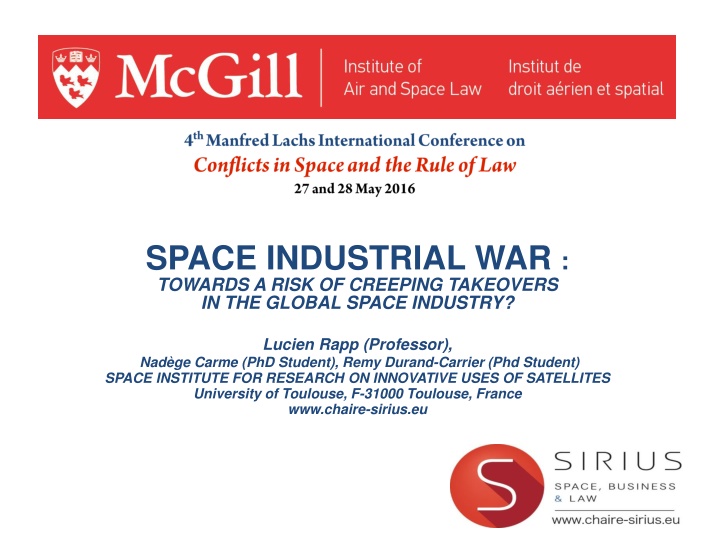

![Read⚡ebook✔[PDF] Linking the Space Shuttle and Space Stations: Early Docking Te](/thumb/21519/read-ebook-pdf-linking-the-space-shuttle-and-space-stations-early-docking-te.jpg)
![READ⚡[PDF]✔ Emerging Space Powers: The New Space Programs of Asia, the Middle Ea](/thumb/21554/read-pdf-emerging-space-powers-the-new-space-programs-of-asia-the-middle-ea.jpg)


